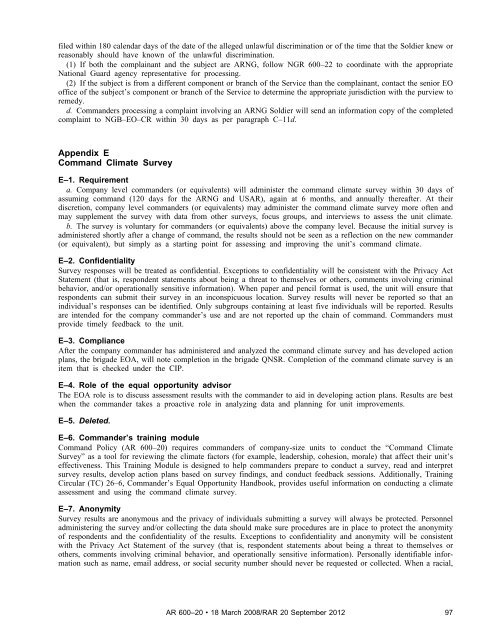AR 600-20, Army Command Policy - Army Publishing Directorate ...
AR 600-20, Army Command Policy - Army Publishing Directorate ...
AR 600-20, Army Command Policy - Army Publishing Directorate ...
Create successful ePaper yourself
Turn your PDF publications into a flip-book with our unique Google optimized e-Paper software.
filed within 180 calendar days of the date of the alleged unlawful discrimination or of the time that the Soldier knew or<br />
reasonably should have known of the unlawful discrimination.<br />
(1) If both the complainant and the subject are <strong>AR</strong>NG, follow NGR <strong>600</strong>–22 to coordinate with the appropriate<br />
National Guard agency representative for processing.<br />
(2) If the subject is from a different component or branch of the Service than the complainant, contact the senior EO<br />
office of the subject’s component or branch of the Service to determine the appropriate jurisdiction with the purview to<br />
remedy.<br />
d. <strong>Command</strong>ers processing a complaint involving an <strong>AR</strong>NG Soldier will send an information copy of the completed<br />
complaint to NGB–EO–CR within 30 days as per paragraph C–11d.<br />
Appendix E<br />
<strong>Command</strong> Climate Survey<br />
E–1. Requirement<br />
a. Company level commanders (or equivalents) will administer the command climate survey within 30 days of<br />
assuming command (1<strong>20</strong> days for the <strong>AR</strong>NG and US<strong>AR</strong>), again at 6 months, and annually thereafter. At their<br />
discretion, company level commanders (or equivalents) may administer the command climate survey more often and<br />
may supplement the survey with data from other surveys, focus groups, and interviews to assess the unit climate.<br />
b. The survey is voluntary for commanders (or equivalents) above the company level. Because the initial survey is<br />
administered shortly after a change of command, the results should not be seen as a reflection on the new commander<br />
(or equivalent), but simply as a starting point for assessing and improving the unit’s command climate.<br />
E–2. Confidentiality<br />
Survey responses will be treated as confidential. Exceptions to confidentiality will be consistent with the Privacy Act<br />
Statement (that is, respondent statements about being a threat to themselves or others, comments involving criminal<br />
behavior, and/or operationally sensitive information). When paper and pencil format is used, the unit will ensure that<br />
respondents can submit their survey in an inconspicuous location. Survey results will never be reported so that an<br />
individual’s responses can be identified. Only subgroups containing at least five individuals will be reported. Results<br />
are intended for the company commander’s use and are not reported up the chain of command. <strong>Command</strong>ers must<br />
provide timely feedback to the unit.<br />
E–3. Compliance<br />
After the company commander has administered and analyzed the command climate survey and has developed action<br />
plans, the brigade EOA, will note completion in the brigade QNSR. Completion of the command climate survey is an<br />
item that is checked under the CIP.<br />
E–4. Role of the equal opportunity advisor<br />
The EOA role is to discuss assessment results with the commander to aid in developing action plans. Results are best<br />
when the commander takes a proactive role in analyzing data and planning for unit improvements.<br />
E–5. Deleted.<br />
E–6. <strong>Command</strong>er’s training module<br />
<strong>Command</strong> <strong>Policy</strong> (<strong>AR</strong> <strong>600</strong>–<strong>20</strong>) requires commanders of company-size units to conduct the “<strong>Command</strong> Climate<br />
Survey” as a tool for reviewing the climate factors (for example, leadership, cohesion, morale) that affect their unit’s<br />
effectiveness. This Training Module is designed to help commanders prepare to conduct a survey, read and interpret<br />
survey results, develop action plans based on survey findings, and conduct feedback sessions. Additionally, Training<br />
Circular (TC) 26–6, <strong>Command</strong>er’s Equal Opportunity Handbook, provides useful information on conducting a climate<br />
assessment and using the command climate survey.<br />
E–7. Anonymity<br />
Survey results are anonymous and the privacy of individuals submitting a survey will always be protected. Personnel<br />
administering the survey and/or collecting the data should make sure procedures are in place to protect the anonymity<br />
of respondents and the confidentiality of the results. Exceptions to confidentiality and anonymity will be consistent<br />
with the Privacy Act Statement of the survey (that is, respondent statements about being a threat to themselves or<br />
others, comments involving criminal behavior, and operationally sensitive information). Personally identifiable information<br />
such as name, email address, or social security number should never be requested or collected. When a racial,<br />
<strong>AR</strong> <strong>600</strong>–<strong>20</strong> 18 March <strong>20</strong>08/R<strong>AR</strong> <strong>20</strong> September <strong>20</strong>12<br />
97
















